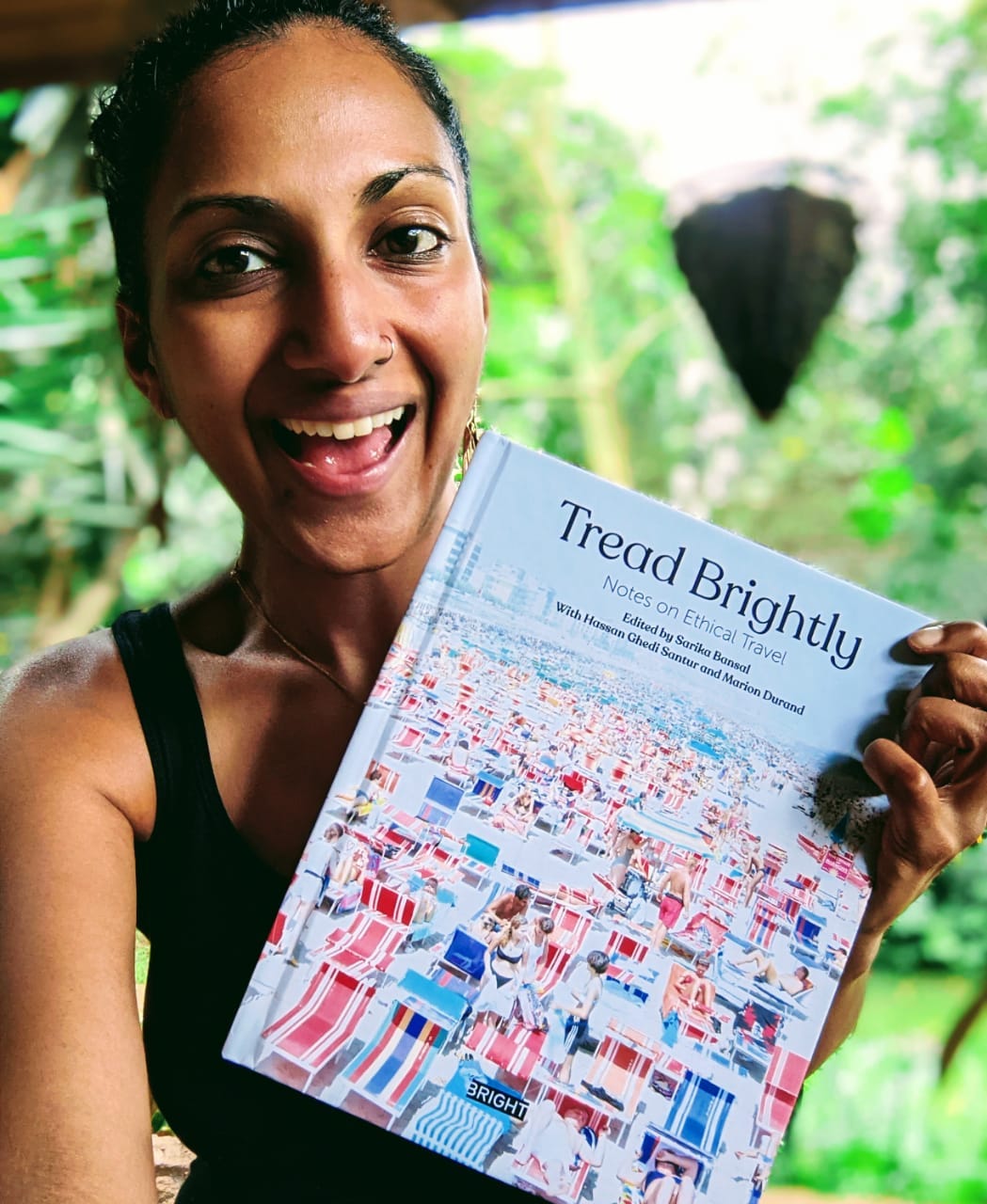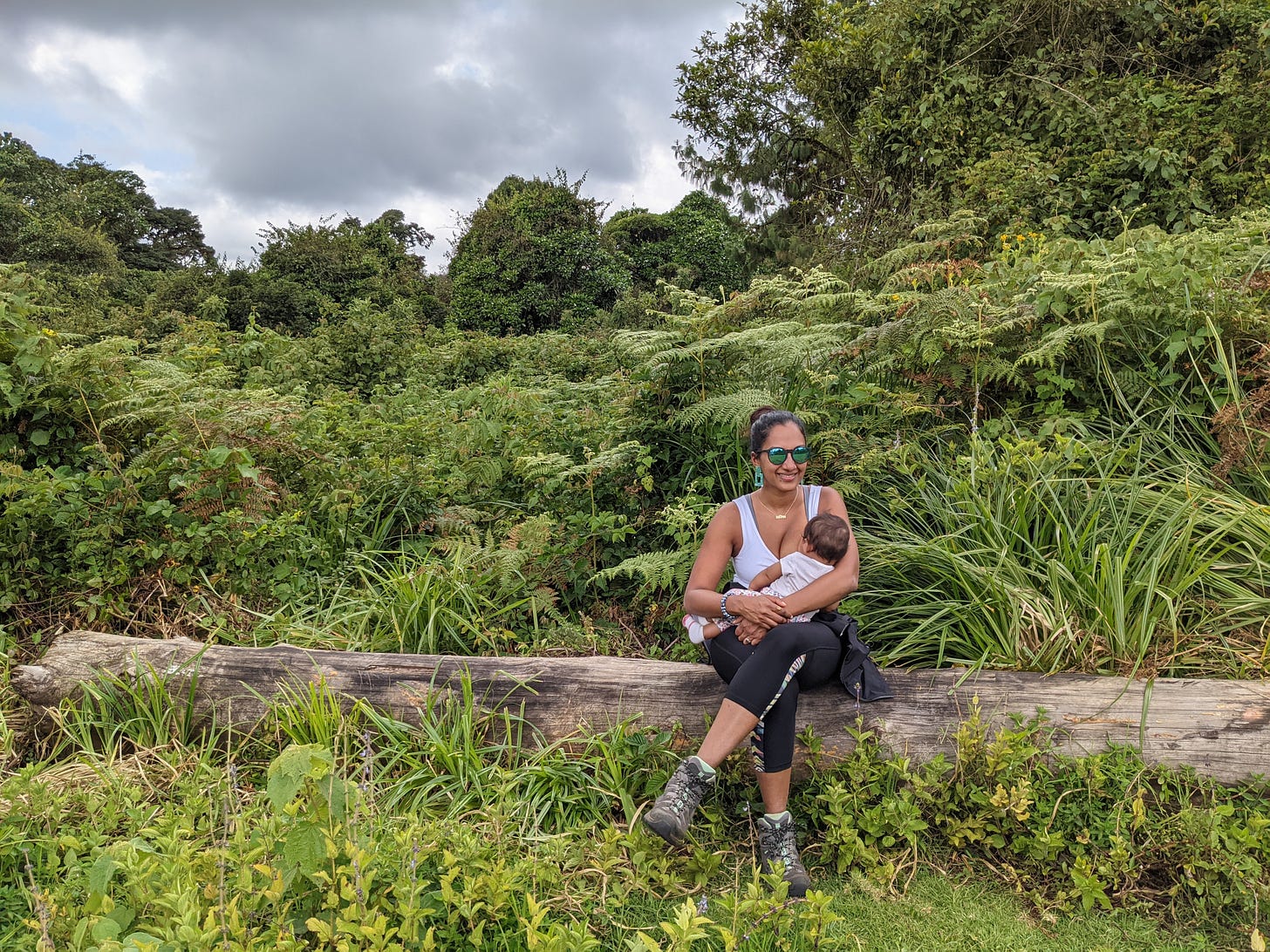As many of us contemplate what it would be like to go somewhere new after so much sacred study of our own little geographies, how might we do it all differently?
That is the question threaded through my dear friend and collaborator Sarika Bansal’s new anthology, Tread Brightly. Sarika and I met through our work at The Solutions Journalism Network and have been nurturing a friendship of mutual obsessions and mindsets ever since. She’s brilliant, first of all; perhaps more than almost anyone I know, she is a systems thinker. One of the things I love about her is that systems don’t appear to intimidate her; she analyzes them and then still finds a leverage point where she thinks she might be able to do her part to bend the system towards justice. Most people I know who can think as big as she can get lost in the thinking; she seems to somehow manage to navigate big, complex systems with a spirit of studied optimism.
She’s brought that spirit to this new project. I think you’ll love it, and her, as much as I do. (And as many of you found me through one of my most popular pieces of writing, “The Reduction Seduction of Other People’s Problems,” you have Sarika to thank for that. She was my editor. So in a sense, maybe she is our cupid, too?!)
Courtney Martin: When people hear “travel writing,” I think they usually associate it with either elite vacations or hardcore adventure stuff. What is this book about and why does it bust up those stereotypes?
Sarika Bansal: So much of “travel writing” puts an emphasis on the traveler, helping them consume as much as possible when they step outside their home. Where to go to drink the best wine, climb the prettiest mountain, visit the best museum, take the sexiest photo for the ‘gram. What if we instead thought about travel as an active exchange? What if we paid attention to the impact our travel has on the lives of others and the places we choose to visit?
Importantly, Tread Brightly is not a guide with pat answers to any of these questions. Travel is so personal, and there is no single way to travel ethically. The book is intended to help you think intentionally about how and where you show up in the world.
The essays in Tread Brightly—which are written and photographed by a hugely talented group of people, including yourself!—are all trying to answer one basic question: When we visit new places, how do we show up? A “visit” can refer to a short-term holiday, a longer trip for work, study, or volunteering, or even moving to a new location. A “new place” can be across the globe or even across the street. And “show up” can refer to the mode of transportation you take, how you participate in a place’s local economy, or how you treat everyone you meet on the way.
What was your biggest surprise while putting this anthology together?
I would be remiss if I didn’t say: I certainly didn’t expect a pandemic to arrive when the book was about ready for publication! It forced Tread Brightly to be delayed by almost a year, which if I’m honest was a blessing.
Covid forced us to find newness close to home, whether we wanted to or not. It made me personally rethink my own travel habits, which extended to how I edited the book. I became a mom early in the pandemic, and I spent untold hours breastfeeding while copy editing the 128 pages that comprise Tread Brightly. I found myself reflecting on how I’ve spent much of my life taking the familiar for granted, instead choosing to fling myself to faraway locations at the drop of a hat.
By contrast, I was now glued to one spot with new life attached to me, unable to go anywhere for so many reasons, editing essays about travel—and yet, I felt like I was on the most profound journey of my life. I didn’t have to brandish my passport to get that same high I usually get from entering a new city or country. That tension has stayed close to my heart.
You’ve traveled extensively, living many of the questions in the book. If you could isolate one burning question about your own approach to travel that is still unsolved and on your mind/heart, what would it be?
I have a hard time gauging how much to trust people I meet on the road. My instinct is to assume everyone is good-hearted and equally interested as I am in meeting someone new. And some of my best travel stories start with me letting my guard down and getting to know other people as human beings.
For example, that attitude is how I once ended up on a boat cruise in northern Brazil at 9am with a group of octogenarian travelers who drank beer, laughed way too loudly, and taught me how to samba. They were all in their bathing suits, completely at ease with their aging bodies, and encouraged me to be comfortable with mine.
Of course, that approach can lead to people trying to take advantage of you. The week prior to the boat cruise, while I was reporting in Sao Paulo, a person I interviewed tried to rob me—right after we shared a two-hour lunch and I had learned intimate details about their life. I blamed myself for being too smiley and open, for presenting myself as an easy target.
I’m still figuring out the right combination of “I’m an open book and ready for whatever life has in store” and “don’t try any funny business with me.”
Travel writing has historically been such a White-dominated space. Who are your favorite travel/adventure writers of color? (I'll throw in one of mine: Amanda Machado!)
I think of travel writing more expansively than compilations of the best beach bars in Bora Bora (though if you’re going to Bora Bora, that list might be useful—no judgment at all!). Some journalists, fiction writers, and poets are masterful at bringing you to new places and opening up new worlds to you.
A few names that come to mind: Pico Iyer single handedly made me want to go to Japan and also return to India with his wisdom. Linda Villarosa’s journalism always brings me to the place she’s reporting from, most recently her hometown in Colorado. Ravinder Bhogal is a Kenyan-Indian chef living in the UK who writes tenderly about her experiences growing up and how she cooks “proudly inauthentic” immigrant food. Joanna Franco makes videos on YouTube and Instagram that make you want to learn a new language and live boldly. And I recently finished Wanjiru Koinange’s debut novel The Havoc of Choice—she’s a Kenyan author who brings to life her home country during a contentious moment.
You are a newish mother. How do you hope your daughter thinks about travel differently than you did as you were growing up?
My one-year-old daughter Ayla is shaping up to be an intrepid little soul who loves to be outside. She could spend hours picking at leaves and watching the neighborhood monkeys. She started walking a few weeks ago, and she moves with purpose, poise, and determination. That’s already tremendously different from what I was like: I was an indoor kid who was scared of everything.
I just hope Ayla retains that adventurous spirit as she grows up, and that she continues to be awed by the tiniest things. Travel is a mindset, not a destination.
I’m making a donation to The Banyan, an organization that is working on mental health in India, on our behalf in honor of Sarika. Thank you for your ongoing support of this newsletter, which I see as an investment in my creativity and labor, but also an investment in my larger network of amazing writers and friends who are featured here. So grateful.
And a note to subscribers: you might have noticed that I didn’t send out my Sunday Times Snapshot last Sunday. I will still be doing it over the summer, but not as consistently. My schedule is a little more haphazard on the weekends and I’m giving myself some space to do it when it’s fun and flowy, and not stress about it when it’s not. You will still be getting my Wednesday and Friday dispatches consistently.






I appreciate you modeling the “when I feel like it” publishing schedule, giving yourself permission to NOT publish and permission to experience zero angst over it.